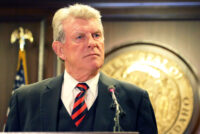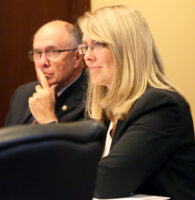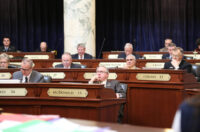Idahoans are investing big in what they say is their No. 1 priority — public education.
At least 45 communities approved $695 million in local school bonds and levies in March.
And lawmakers have padded those local tax dollars with a cranked-up overall K-12 state budget of $1.7 billion — nearly a $100 million increase from last year and up more than $300 million from 2015.
All seven public education budgets sailed through the House this legislative session in 28 minutes, and through the Senate in 43 minutes. No debates — just a quiet handful of dissenting votes.
The big-money investments in K-12 reflect the opinions of many Idahoans, who pegged education as their top priority in two separate polls.
The 2017 “People’s Perspective,” a public opinion poll conducted by Idaho Education News, found that Idahoans consider education their No. 1 priority — ahead of the economy and the environment. Eduction overwhelmingly topped the list of important issues in a public policy survey conducted by Boise State University last year.
But respondents in both surveys say there’s plenty of room for improvement. The People’s Perspective found that 53 percent of the 1,004 Idahoans polled would grade their local schools a C or lower. A scant 7 percent believe “the state’s public school system is in very good shape and needs little change.”
Lawmakers and education leaders say the recent financial investments in education need time to play out.
Here’s a closer look at some of those investments.
Big-money initiatives
Gov. Butch Otter again identified education as his top priority during his 2017 State of the State address. He applauded the success of his first task force and unveiled another — this one focused on higher education. The 36-member team started its work last month.

Lawmakers rallied behind Otter’s push, often at breakneck pace, boosting funding by 7.4 percent in 2015-16 and again in 2016-17. Otter signed the 2017-18 education budgets into law earlier this week, increasing K-12 spending by another 6.3 percent.
Otter’s 2013 K-12 task force provides much of the framework for the recent uptick in commitments and spending. In 2013, the task force drilled down 20 reform recommendations, from teacher raises to a new literacy initiative.
Some recommendations have garnered more attention — and money — than others over the past few years:
- Career ladder teacher compensation model ($135 million): This has combined “competitive salaries with incentives, rewards and accountability.” Lawmakers recently approved $62 million in teacher raises for 2017-18 — the heaviest lift of the five-year plan to boost teacher pay.
- Restoring operational funding to pre-recession levels ($94 million): This has bolstered school districts’ overall costs for doing business, including utilities and fuel expenses, content materials and training for teachers.
- Educator and student technology devices ($23 million): This is aimed at giving more “adequate access to technology devices, with appropriate content to support equal access and opportunity.”
- Job-embedded professional learning ($20 million): This bolsters professional development programs for teachers by encouraging districts to provide regular learning opportunities.
All told, spending tied to the task force’s recommendations exceed $300 million since 2015.
New investments need time to play out
The Pocatello-Chubbuck School District has credited extra funding for professional development as key to an unusual uptick in its most recent batch of ISAT scores.
Statewide, the 2016 ISAT scores revealed slight but across-the-board increases in academic achievement, but also underscored some concerns, especially in math, where only 31 percent of high school students scored advanced or proficient.
Last year’s SAT scores yielded results similar to last year’s ISAT scores. In the writing and reading section of the test, 62 percent of high school juniors met the exam’s college- and career-readiness benchmark. Yet only 35 percent hit the test’s math benchmark.
Idaho’s most recent college go-on rate, 46 percent, sputters well below the State Board of Education’s stated goal of 60 percent, despite marked increases in the number of students cashing in on an extra $6 million earmarked for advanced opportunities as of last year. (Slightly more than 30,000 Idaho students took dual enrollment courses in 2008, but that number has since tripled.)
Rep. Wendy Horman, R-Idaho Falls, called for continued vigilance in tracking student achievement now and in the coming years.

“We should be paying attention to what’s working,” Horman said. “We should also be looking closely at the data.”
Horman, a member of the Joint Finance-Appropriations Committee, said financial investments need time to play out. She pointed to the $6 million advanced-opportunities push and $135 million in teacher raises.
“Last year was the first year we saw real money for advanced opportunities,” Horman said.
It will take more time to see if added money from the career equates to improved teacher recruitment and retention, Horman said. “We needed to get teacher salaries up. Hopefully that’s recognized and appreciated.”
But as lawmakers continue to invest in teacher pay, they want accountability through evaluations and master-teacher premiums. According to the People’s Perspective, most Idahoans (83 percent) say teachers should be measured by student growth via test scores.
Some educators say data derived from standardized test scores and other measures are a useful way to gauge student growth, but caution against using them to evaluate teachers and schools.
“For one thing, not all schools in Idaho are the same,” said Bonneville School District superintendent Chuck Shackett. “Go to an affluent district and you’ll see teachers knock test scores out of the ballpark, but in impoverished ones, not so much.”
(An EdNews analysis of 2016 SBAC scores revealed that schools with higher poverty rates tended to score lower on the SBAC, and vice versa.)
State Department of Education Spokesman Jeff Church also called for patience in scrutinizing the big-money push. He said some of the measures are helping, at least along anecdotal lines.

Church and SDE director of mastery-based learning Kelly Brady recently returned from visiting several schools in the midst of the task force-driven push toward mastery-based learning — which advances students through schools based on command of subject material, not seat time.
“It’s meeting kids’ individual needs,” Brady said. “And there seems to be more student engagement.”
Church echoed Brady, but said schools are still in the design phase.
“It’s a long process,” Church said.
Disclosure: The J.A. and Kathryn Albertson Family Foundation paid for the People’s Perspective, and funds Idaho Education News.

